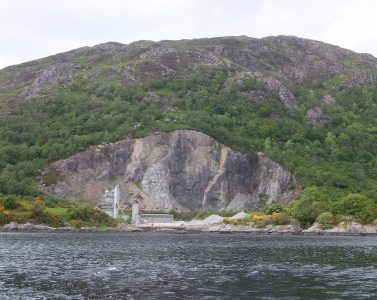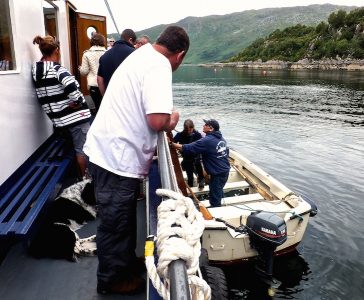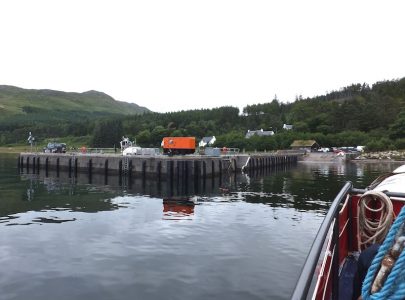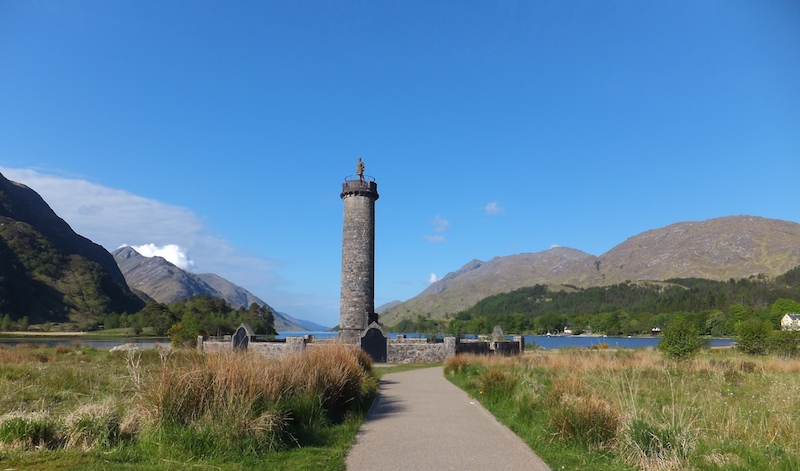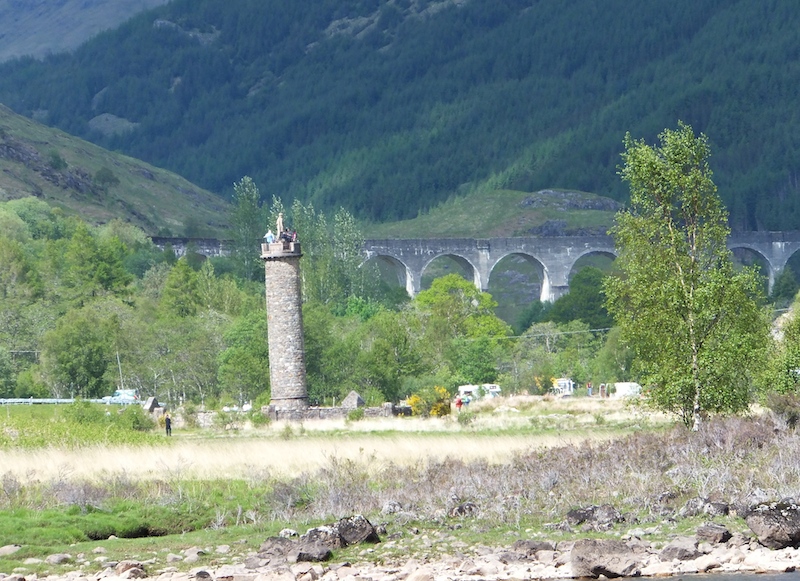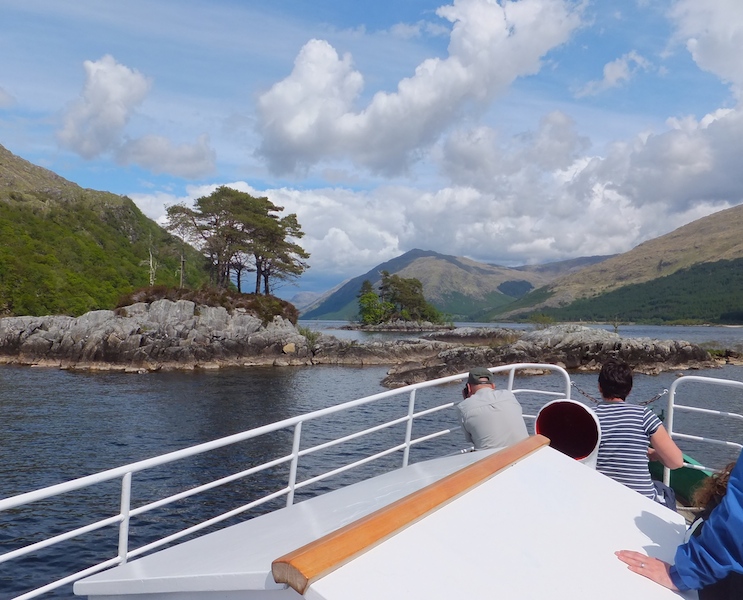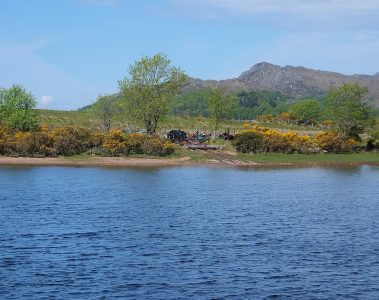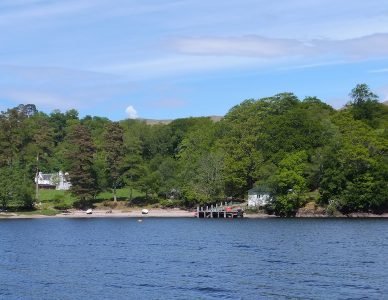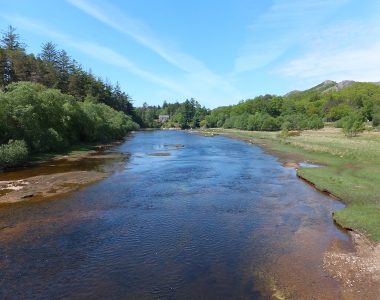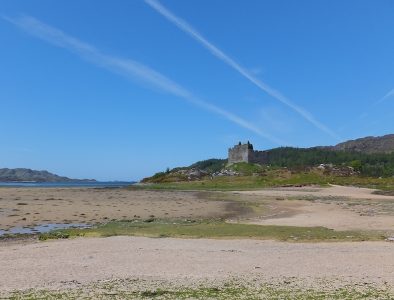With nearly 40 years’ experience as a boat owner, Ken Mills has more than a passing acquaintance with the lochs of the Clyde and Western Isles: there are few he didn’t manage to visit at one time or another. Since giving up his boat a few years ago, he has tried to revisit those lochs he considered worthy of further exploration, using public services. Here he relates his experiences of three that feature rarely, if at all, in the itinerary of ship enthusiasts.
LOCH ETIVE
I had sailed into Loch Etive a few times but never beyond North Connel, so in 2014 I determined to make the sail to the top of the loch with the now defunct Loch Etive Cruises operated by Donald Kennedy. They used a former workboat, Mara, with chairs on the open deck for 12 passengers abaft the wheelhouse. From the photograph it will be seen that she is a very basic craft and if it rained — well you got wet! Mara departed from Kelly’s Pier, close to Taynuilt, but on the day I travelled we were delayed, awaiting three booked passengers from Fort William. This resulted in us not quite getting to the top of the loch, and I was therefore denied a photograph of the Old Pier at its head. I had however previously made the journey by road from Glencoe to Lochetivehead, and had taken a photograph then of the pier remains.
Once under way we shortly passed, on the north side of the loch, Bonawe Quarries previously in the ownership of J & A Gardner. This brought back childhood memories, for they operated a small fleet of coasters prefixed ‘Saint…’ which carried stone from the quarries all the way to the Clyde.
The bus terminus which took me home from school was adjacent to the quay, and not only did I witness the cargo being discharged but occasionally I would see one of the vessels making its way under the three bridges and suspension bridge with masts and funnel lowered. A photograph taken of a painting depicts one of these vessels discharging. In those days J & A Gardner’s offices were sited in Clyde Street opposite the quay.
There was little to see in the way of habitation as we proceeded up the loch. There were a few stalking lodges accessible only by boat, and after Taynuilt we didn’t even see a boat. There was plenty of wildlife: the skipper pointed out a pair of golden eagles. The loch is dominated by high hills on either side and it seems there is a rough path running down the south side.
Proceeding up the loch great views were to be had of the twin peaks of Buchaille Etive Mor and Buchaille Etive Beag. On the day of my trip visibility was good and the rain managed to stay off. Blankets were offered by the skipper to those passengers who were cold!
Even though we didn’t quite make it to the head of the loch and the weather was dull, it was a good £15 worth, with a cup of tea included. Given the opportunity, I would definitely go again and would recommend it for the scenery and wildlife alone.
Loch Etive Cruises did not operate in 2015 or 2016. Donald Kennedy has retired: Mara’s future depends on the sale of the business to a new owner.
LOCH NEVIS
Until recently I had never ventured further up Loch Nevis than Inverie, the main community on the Knoydart peninsula. I was determined to put this to rights, so I drove to Mallaig and from there sailed to the head of Loch Nevis on Western Isles, which was offering a morning and afternoon ferry service to Inverie, with the afternoon service extended to Tarbet and a cruise to the head of the loch. Above Tarbet Loch Nevis narrows at Kylesmorar and a passage is negotiated between a number of small islands into the upper loch. A strong tide runs through between the islands.
Since my previous visit to Loch Nevis, Knoydart had been subject to a community buy-out and I was anxious to see what changes had taken place. I took the morning service to Inverie and, after time ashore, rejoined Western Isles for the afternoon sailing to the head of the loch. When we entered Loch Nevis, the French cable-laying ship René Descartes was laying broadband cable to Knoydart. I had seen this vessel the previous week laying cable from Kintyre to Arran. It gets around!
Changes at Inverie — well there was now a pub where previously it was a club entry, for which as a visitor you signed the book and were admitted as a member! There was now a new substantial pier and several new houses, with the church converted to a dwelling house. The big house seemed to be in American ownership and was undergoing substantial upgrading. I know this for, as a curious trespasser, I was warned off the grounds by two angry Americans. During my visit the ex landing craft type vessel Spanish John arrived carrying a large container of supplies, pulled off the vessel by Land Rover. Enquiries subsequently revealed that Spanish John, based at Mallaig, is used for general cargo work around the west coast, serving remote locations, fish farms and the like.
Western Isles duly arrived in the afternoon and a number of us joined an already busy vessel for the afternoon cruise. We passed some distance from Ardintigh, a small village before Tarbet where Tom MacLean’s Highland Outdoor Centre is based. I had heard of his 65ft boat constructed in the shape of a large whale and saw it in the distance on the beach. Sadly the photograph I took was blurred but an image is shown of it afloat. He apparently made several voyages in this and intended to take it across the Atlantic but this as I understand is yet to happen (if it ever does!).
We stopped at Tarbet where there was both an embarkation and disembarkation using a tender. The church close by the shore is now a bunkhouse but there are very few houses. The village can be reached by a track coming from a point near Morar, but normally access is by boat. It is at Tarbet that the impresario Sir Cameron MacIntosh has his house which was badly destroyed by fire some years ago. It has since been reinstated. Western Isles then moved up the loch, negotiating the narrows at Kylesmorar where there is a small scattering of houses — mostly self catering and serving the climbing community. We sailed almost to the head of the loch before sailing back directly to Inverie and then Mallaig.
I found Western Isles to be extremely well appointed for its size (c65ft and 80 passengers), with room to move about and a service of light refreshments. In Loch Nevis itself there is a lot to see both in terms of wildlife and scenery. It is Scotland at its very best — particularly on a good day, which it was my good fortune to choose. An excellent commentary was given during the cruise. There is little activity on the loch, which has no road access apart from tracks.
When under the ownership of Bruce Watt, Western Isles was chartered to serve the Small Isles while the CalMac vessel was being overhauled, and it was interesting to sail on her for that reason alone. More information from Western Isles Cruises
LOCH SHIEL
The third of my ‘Three Lochs with a difference’ is an inland loch, though not far from Loch Moidart — a sea loch. I have always been interested in the exploits of Prince Charles who landed at Loch Moidart in 1745 and made his way by boat along Loch Shiel to Glenfinnan, where his standard was raised. My other interest in the loch is sentimental, in that the house we bought near Glasgow 40 years ago was called Glenfinnan — the name it retains to this day. I felt I had to take a sail on this loch.
In days gone by there was a daily service between Acharacle and Glenfinnan. At Glenfinnan mail and cargo were picked up initially from a coach connecting with the train at Fort William and then, on the opening of the Fort William-Mallaig line in 1903, from Glenfinnan station, from where they were distributed to the loch side communities on the return sailing to Acharacle. Having local interests in the area, David MacBrayne ran a service for a short period in the 1890s using a small vessel named Maud — mainly to provide a connection for tours operating out of Oban at the time. The principal service was operated by the Moidart estate landowner until just after the First World War, when it was taken over by the Loch Shiel Steamboat Company Ltd, which had been formed by various local parties. When its finances began to deteriorate MacBraynes were asked in 1951 to take it over, and commissioned two launches for the service — Lochailort and Lochshiel.
After a road connection to Acharacle opened in 1967 the regular service ceased, to be followed by seasonal cruises by various operators. Even before that, however, Lochshiel had been moved in 1962 to Iona to serve as a tender and ferry boat. Lochailort transferred to Kyle in 1968 and served for about a year on the Toscaig service. The 1977 edition of CRSC’s Clyde Steamers magazine gives an extensive history of sailings on Loch Shiel, written by Fraser MacHaffie.
In 1997 Jim Michie introduced timetabled seasonal cruising from Glenfinnan, using a 1940 ex Admiralty harbour launch named Sileas. The boat is well fitted out with both open and covered accommodation, including a small bar serving teas/coffees and light snacks. Sileas can carry about 50 passengers. Short cruises of up to two-and-a-half hours are offered during the week, with a more extended cruise on Wednesdays to Acharacle with request stops at Polloch and Dalilea. I chose the full day cruise, and with only 20 passengers on board there was plenty of room. As I had previously sailed into Loch Moidart on my own boat, I decided to take my bike: in the one and a half hour break at Acharacle I calculated I would have time to cycle to Loch Moidart and visit Castle Tioram, sited on a tidal island at the entrance to the loch.
As we sailed down the loch from Glenfinnan the scenery was of the very best, and the enthusiasm of Jim Michie, Sileas’ skipper, for the history and wildlife of the area was quite infectious. We saw two golden eagles and one sea eagle. A full commentary was given on the history of Green Island, with its historic chapel and ancient graves, which on the day we sailed was bathed in a sea of bluebells. Apparently clan funerals still take place there if the clan chief, MacDonald of Clanranald, consents. As we approached Acharacle the old MacBrayne slipway was pointed out — still in use today for Sileas’ annual hull inspection. Several of the former piers were still visible in varying states of repair.
In the time given at Acharacle I managed to cycle to Loch Moidart and as the tide was out I was able to walk out to Castle Tioram — but was denied entry because of major works to the fabric.
For the return a few passengers joined at Acharacle, having made the journey round by bus from Glenfinnan, and a few left to return likewise. Before finally tying up at Glenfinnan we were taken to a point further up the loch where the skipper was anxious to show us that the Glenfinnan monument is off the perpendicular, being inclined to the left when viewed from the loch — something not so obvious when seen from the road.
Even if you don’t have time for the full cruise, which I would always prefer, I would recommend one of the shorter trips. More information from Loch Shiel Cruises
This is the second article in a series previewing summer cruise options outside the CalMac/Waverley sphere. The first was Rob Beale’s exploration of Loch Lomond.














